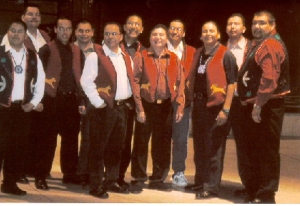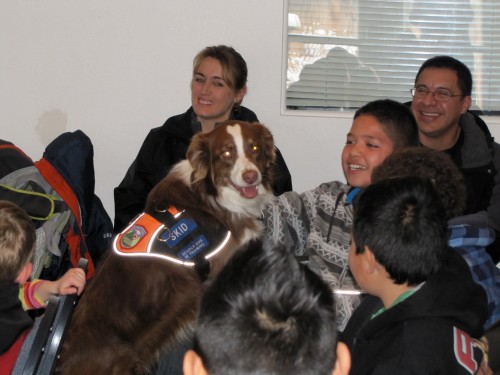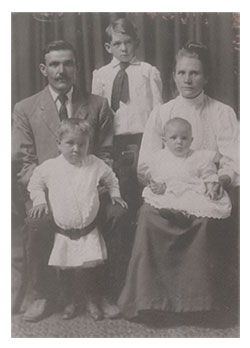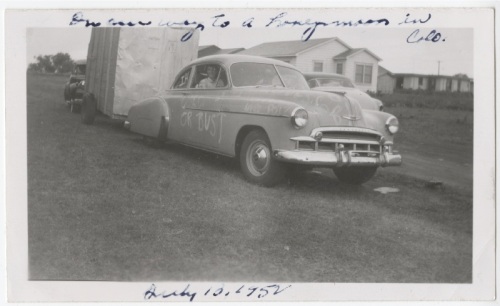by Cory Gundlach, Exhibit Designer
 In honor of Native American Awareness Month, I’d like to share a recent experience I had at the Exhibit Museum of Natural History at the University of Michigan. “Native American Dioramas in Transition” includes fourteen dioramas on Native American cultures, each of which now includes contextual information far beyond the institutional didactics that first accompanied the exhibit over fifty years ago. In order to give you a general sense of the environment that surrounds this exhibit, I think it’s helpful to know a little bit about the museum itself. From the densely ornate rotunda, a grand stairway leads to exhibits on the upper levels. The second floor has exhibits on prehistoric life, the third—Michigan wildlife, and the fourth—anthropology, geology, a planetarium, education room, gallery for temporary exhibits, and administrative offices. As you enter the fourth floor, “Native American Dioramas in Transition” is the first thing you see. It is predominantly modular in design, composed of two horizontal registers built into the wall. Each includes seven dioramas, one above the other. The exhibit basically exists in the hallway leading to other galleries and offices, although on the far right end of the installation, disconnected from the dioramas, there is a supplementary display of contemporary quotes. These are comments taken from the public, ranging from elementary school students, their aides and teachers, to PhDs who work at the university and elsewhere. These comments are also superimposed over and around the dioramas. They are brightly colored and simply designed, and they dominate the exhibit—both visually and contextually. In some cases, they obstruct the view into the diorama:
In honor of Native American Awareness Month, I’d like to share a recent experience I had at the Exhibit Museum of Natural History at the University of Michigan. “Native American Dioramas in Transition” includes fourteen dioramas on Native American cultures, each of which now includes contextual information far beyond the institutional didactics that first accompanied the exhibit over fifty years ago. In order to give you a general sense of the environment that surrounds this exhibit, I think it’s helpful to know a little bit about the museum itself. From the densely ornate rotunda, a grand stairway leads to exhibits on the upper levels. The second floor has exhibits on prehistoric life, the third—Michigan wildlife, and the fourth—anthropology, geology, a planetarium, education room, gallery for temporary exhibits, and administrative offices. As you enter the fourth floor, “Native American Dioramas in Transition” is the first thing you see. It is predominantly modular in design, composed of two horizontal registers built into the wall. Each includes seven dioramas, one above the other. The exhibit basically exists in the hallway leading to other galleries and offices, although on the far right end of the installation, disconnected from the dioramas, there is a supplementary display of contemporary quotes. These are comments taken from the public, ranging from elementary school students, their aides and teachers, to PhDs who work at the university and elsewhere. These comments are also superimposed over and around the dioramas. They are brightly colored and simply designed, and they dominate the exhibit—both visually and contextually. In some cases, they obstruct the view into the diorama:
I like the dioramas because you can see new things that are different from what you’ve already seen. Native American people used different things than we do. They had different houses and foods, probably because they couldn’t find as many things as we have and maybe because they couldn’t pay for them.
–Liam Coolican, Third Grader, Bach Elementary, Ann Arbor
 The original dioramas are well-crafted, romantic interpretations of indigenous cultures, dating to 1959. They are what you would expect from a big expensive university museum whose entry is flanked by the dusty white marble busts of its founding fathers. As you stoop down to gaze into some of these little boxes, you can just imagine yourself among the nude and scantily clad Indians going about their daily business, thanks to Dr. Robert S. Butsch, “a zoologist and museum preparator of European descent.” Superimposed over the diorama on the Haida, portrayed within the idyllic landscape on the Northwest Coast, a sticker label reads, “Who Tells the Story?”, and the other, “Native Americans were not consulted when these dioramas were made.”
The original dioramas are well-crafted, romantic interpretations of indigenous cultures, dating to 1959. They are what you would expect from a big expensive university museum whose entry is flanked by the dusty white marble busts of its founding fathers. As you stoop down to gaze into some of these little boxes, you can just imagine yourself among the nude and scantily clad Indians going about their daily business, thanks to Dr. Robert S. Butsch, “a zoologist and museum preparator of European descent.” Superimposed over the diorama on the Haida, portrayed within the idyllic landscape on the Northwest Coast, a sticker label reads, “Who Tells the Story?”, and the other, “Native Americans were not consulted when these dioramas were made.”
 Another reads,
Another reads,
Do Indians Belong with Dinosaurs?
Visitors arrive at the dioramas after passing by extinct dinosaurs, stuffed animals, and an endangered species exhibit. Some museum visitors, especially children, get the impression that Native Americans are just like the dinosaurs—extinct. Or that they are somehow “primitive” because they are displayed with wildlife.
It is critical to note that after fifty years, this exhibit will soon close—dioramas and all. This comes after years of feedback from the public. But rather than simply remove what has been an embarrassment for some time, the museum had the foresight and humility to recontextualize this embarrassment into a contemporary dialogue on the politics of display, which, in this case, literally “puts people in a box.” This colonial gaze as method of display sits beside a text panel that advocates the cooperation of museums with indigenous peoples. A specific example is provided that takes place at the Ziibiwing Center of Anishinabe Culture & Lifeways in Mount Pleasant, Michigan, on the Saginaw—Chippewa Indian Tribe Reservation.
I left the exhibit feeling transformed, inspired, and challenged. I felt challenged to become more engaged in cultural exchange and the dialogue that informs the representation of indigenous culture. As an exhibit designer at the Fort Collins Museum & Discovery Science Center, I feel lucky to have a role in these processes, by way of making mounts for objects and interactives, and assisting with programs that advocate the integration of indigenous expression into everyday life. This month, on First Friday, FCM&DSC hosted the Northern Cree singers, originating from the Saddle Lake Cree Nation of northern Alberta. It too was a transforming experience. What the performance lacked in lighting was more than made up for in sound, and I think perhaps the sound was more powerfully expressed because of it. In only three songs, I was deeply moved. Nearly to tears in fact. After the first song, a statement was given about how the public receives the music of the Northern Cree. While many have never heard it, it is somehow familiar, and this deep familiarity is the power that unites humanity. The next day I was lucky enough to see Northern Cree (who performed three times) and many others perform at the 27th Annual Pow-Wow at Colorado State University. This performance came just after I witnessed Kevin Locke’s hoop dance and flute songs at Laurel Elementary. As I reflect on the emotions that overcame me at both performances, above all I feel proud to be a part of an institution that advocates indigenous culture. While November may be the only sanctioned month in which to raise awareness of First Peoples, it is of course by no means the only month to do so. Even as museums spearhead this cultural campaign, it is critical to engage within them to ensure that issues of cultural representation are part of a broad public dialogue. What took the Exhibit Museum nearly fifty years to realize, and then publicly address, is an excellent example of how public engagement effects change in museums, and therefore the public at large. I would like to welcome the public to meet this challenge and opportunity as the Fort Collins Museum & Discovery Science Center continues to develop exhibits and programs that stem from the advocacy of indigenous expression as one of the core values of the institution. Participate in museum programs and cultural centers, go to Pow-Wows, and celebrate the opportunity to be a part of something beautiful, enriching, and powerful.
familiarity is the power that unites humanity. The next day I was lucky enough to see Northern Cree (who performed three times) and many others perform at the 27th Annual Pow-Wow at Colorado State University. This performance came just after I witnessed Kevin Locke’s hoop dance and flute songs at Laurel Elementary. As I reflect on the emotions that overcame me at both performances, above all I feel proud to be a part of an institution that advocates indigenous culture. While November may be the only sanctioned month in which to raise awareness of First Peoples, it is of course by no means the only month to do so. Even as museums spearhead this cultural campaign, it is critical to engage within them to ensure that issues of cultural representation are part of a broad public dialogue. What took the Exhibit Museum nearly fifty years to realize, and then publicly address, is an excellent example of how public engagement effects change in museums, and therefore the public at large. I would like to welcome the public to meet this challenge and opportunity as the Fort Collins Museum & Discovery Science Center continues to develop exhibits and programs that stem from the advocacy of indigenous expression as one of the core values of the institution. Participate in museum programs and cultural centers, go to Pow-Wows, and celebrate the opportunity to be a part of something beautiful, enriching, and powerful.
For more information on “Native American Dioramas in Transition,” go to
http://www.ur.umich.edu/0910/Sep28_09/05.php
For the Director’s comment, got to http://www.ns.umich.edu/podcast/video.php?id=1162
To contribute to a discussion on the exhibit, go to
http://www.lsa.umich.edu/exhibitmuseum/exhibits/na_dioramas_in_transition/diorama_discussion
Northern Cree Singers
http://www.northerncree.com/
Kevin Locke
http://www.kevinlocke.com/









 In honor of Native American Awareness Month, I’d like to share a recent experience I had at the
In honor of Native American Awareness Month, I’d like to share a recent experience I had at the  The original dioramas are well-crafted, romantic interpretations of indigenous cultures, dating to 1959. They are what you would expect from a big expensive university museum whose entry is flanked by the dusty white marble busts of its founding fathers. As you stoop down to gaze into some of these little boxes, you can just imagine yourself among the nude and scantily clad Indians going about their daily business, thanks to Dr. Robert S. Butsch, “a zoologist and museum preparator of European descent.” Superimposed over the diorama on the Haida, portrayed within the idyllic landscape on the Northwest Coast, a sticker label reads, “Who Tells the Story?”, and the other, “Native Americans were not consulted when these dioramas were made.”
The original dioramas are well-crafted, romantic interpretations of indigenous cultures, dating to 1959. They are what you would expect from a big expensive university museum whose entry is flanked by the dusty white marble busts of its founding fathers. As you stoop down to gaze into some of these little boxes, you can just imagine yourself among the nude and scantily clad Indians going about their daily business, thanks to Dr. Robert S. Butsch, “a zoologist and museum preparator of European descent.” Superimposed over the diorama on the Haida, portrayed within the idyllic landscape on the Northwest Coast, a sticker label reads, “Who Tells the Story?”, and the other, “Native Americans were not consulted when these dioramas were made.” Another reads,
Another reads, familiarity is the power that unites humanity. The next day I was lucky enough to see Northern Cree (who performed three times) and many others perform at the 27th Annual Pow-Wow at Colorado State University. This performance came just after I witnessed
familiarity is the power that unites humanity. The next day I was lucky enough to see Northern Cree (who performed three times) and many others perform at the 27th Annual Pow-Wow at Colorado State University. This performance came just after I witnessed 
 Our last story from the inaugural
Our last story from the inaugural 

 This week’s story from the
This week’s story from the 



You must be logged in to post a comment.